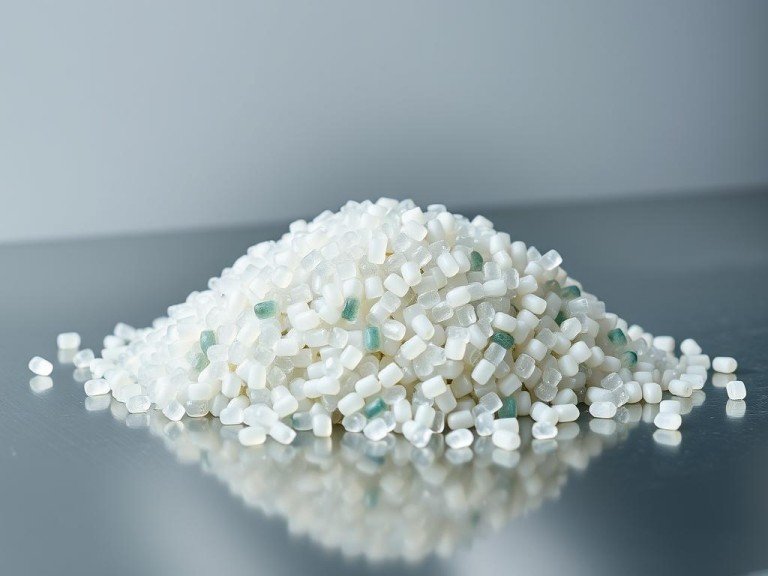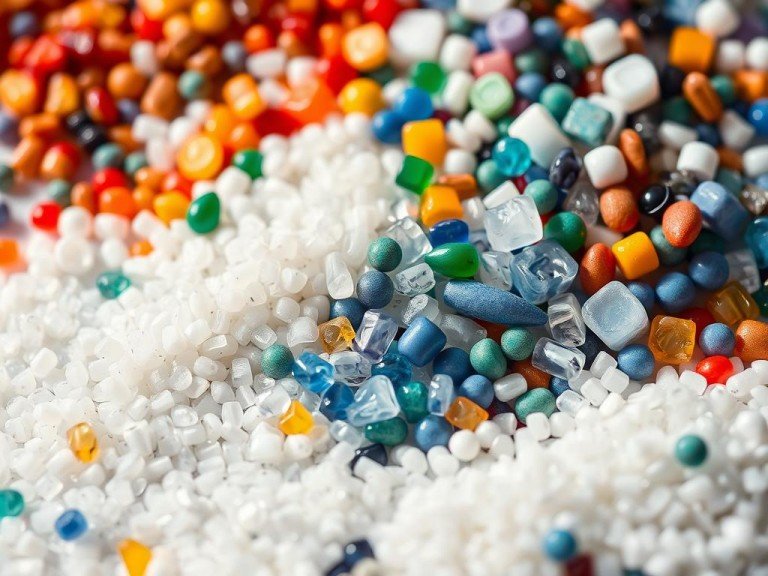As a leading manufacturer of plastic pelletizing machine, I’ve seen how plastic pellets are key in today’s world. These small, versatile granules are the base for many everyday items.
Every year, over 270 million metric tons of plastic are made worldwide. Knowing how pellets are used is key. They are the base for many products, from everyday items to industrial parts, because of their flexibility and wide applications. Exploring the uses of plastic pellets shows they are a key material in today’s production.
The importance of plastic pellets goes beyond their widely used roles. They also raise environmental concerns that companies like IPG take seriously.
What Are Plastic Pellets?
At IPG, we know how important plastic pellets are in many industries. These pellets are a key raw material for making a wide range of plastic products.
Plastic pellets, also known as plastic granules or pellets, are small, uniform particles made from plastic. They are used as the raw material for many plastic-making processes, like injection molding, extrusion, and blow molding. At IPG, we make machines that turn raw plastic or recycled plastic into these uniform pellets.
Making plastic pellets is a complex process. First, the polymer resin is melted and mixed in an extruder. Our machines then shape this molten plastic into strands, which are cut into uniform pellets by rotating blades. For recycled plastic, steps like sorting, cleaning, and removing contaminants are added before recycling. Cooling the pellets is key, using water or air to keep their shape.
The process starts with the polymer resin being fed into an extruder.
Our machines shape the molten plastic into uniform strands.
For recycled plastic, steps like sorting and cleaning are included.
Manufacturing and Industrial Applications
At IPG, we’ve made our pelletizing systems to meet the needs of many manufacturing and industrial uses, showing the importance of plastic pellets.
The use of plastic pellets in making has changed the industry. It lets us make a wide range of products, from simple containers to complex parts.
Injection Molding Process
Injection molding is a big use of plastic pellets. It melts the pellets and injects them into a mold to make the product. This method is great for making parts with detailed designs and exact specs.
The process is very efficient, making it good for mass production with little waste.
It’s used in many fields, like cars, consumer goods, and healthcare.
Extrusion Applications
Plastic pellets are key in extrusion. They melt the pellets and push them through a die to make continuous products like pipes or profiles.
This method is great for making products with the same shape all the way through. It’s very important for industries like construction and packaging.
Looking for more information? Check out How Extruders Work for more insights!

Blow Molding for Containers
Blow molding is a big deal for containers made from plastic pellets. It melts the pellets, shapes them into a parison, and then blows it up in a mold to get the shape.
Blow molding makes containers of all sizes, from small bottles to big drums.
It’s perfect for making containers with complex shapes and thin walls, great for packaging.
Using top-notch plastic pellets makes sure the products are strong and meet standards.
The use of plastic pellets in making plastics shows how important they are in today’s production.
What Are Plastic Pellets Used For in Consumer Products?
At IPG, a leading maker of Pelletizing Machine Plastic, we see how plastic pellets are used in many products we use every day. They are versatile and can be turned into many things, from packaging to electronic parts.
Packaging Materials and Containers
Plastic pellets are key in making packaging materials and containers. They are durable and can be shaped in many ways. This makes them perfect for packaging food, drinks, and other items. They help keep products fresh and extend their shelf life.
Some examples of packaging made from plastic pellets include:
Plastic bottles and containers
Food packaging wraps and bags
Protective packaging like bubble wrap
Household Items and Appliances
Plastic pellets are also used in making household items and appliances. They can be made into different plastics for various needs, like heat resistance or chemical resistance.
| Product | Properties | Benefits |
| Household Appliances | Heat resistance, durability | Long-lasting, efficient |
| Kitchen Utensils | Chemical resistance, flexibility | Easy to clean, versatile |
| Storage Containers | Impact resistance, lightweight | Durable, portable |
Electronics and Automotive Components
The electronics and automotive industries use plastic pellets a lot. They make housings, connectors, and insulators for electronics. These parts need to be stable and not conduct electricity.
Automotive parts are made lighter with plastic pellets. This makes cars more fuel-efficient and stylish.
I’ve seen how important these pellets are. They help make complex parts that meet high standards.
Therapeutic and Sensory Applications
Plastic pellets are key in many fields, like therapy and sensory toys. At Pelletizing Machine Plastic, I’ve seen their impact. They help in child development and therapy.
Weighted Blankets for Anxiety Relief
Weighted blankets with plastic pellets help with anxiety. They offer a calming pressure. This is great for those who feel stressed or anxious.
Sensory Toys and Educational Tools
Plastic pellets are in many toys and tools. “I-spy” bags and sensory bins are examples. They help kids with skills like fine motor and focus.
Plastic pellets are smooth and calming. They’re perfect for special therapy tools. At IPG, we’ve seen their use grow in education and therapy.
Craft and Hobby Uses for Plastic Pellets
Plastic pellets are great for crafts and hobbies. They’re versatile and durable. This makes them perfect for many projects.
Artists and hobbyists love plastic pellets. They use them for decorations and useful items. The pellets are easy to work with.
DIY Projects and Art Installations
Artists use plastic pellets for texture and design. They mix them with other materials for unique effects.
Doll Making and Stuffing
In doll making, pellets add weight and stability. They’re safe to use inside dolls without causing damage.
Rock Tumbling Media
Plastic pellets protect stones in rock tumbling. They keep the stones from chipping during polishing. This makes the process safer and more efficient.
| Application | Benefits |
| Rock Tumbling | Protection, Consistency, Efficiency |
| DIY Projects | Versatility, Texture |
| Doll Making | Weight, Stability |
Plastic pellets are versatile in hobbies. They also help with recycling. Many hobbyists now choose recycled pellets to support green initiatives.
Environmental Impact and Sustainable Practices
IPG is committed to green practices in plastic making. We aim to reduce our environmental impact. This shows our dedication to sustainability.
Challenges of Plastic Pellet Pollution
Plastic pellet pollution is a big problem, affecting our oceans and causing waste buildup. It’s especially bad for marine life because animals can eat these pellets, which can harm them.
Groups like Operation Clean Sweep try to fix this by teaching companies how to handle pellets better. But, we need more action and clear reports to really make a difference.
Industry Initiatives for Responsible Handling
At IPG, we support efforts like Operation Clean Sweep. It teaches companies how to keep pellets from getting into waterways. This is key to cutting down on plastic pollution.
Our team designs pelletizing equipment with safety in mind. We also train our clients on how to handle pellets safely. This helps protect our environment.
| Initiative | Description | Impact |
| Operation Clean Sweep | Promotes best practices in handling and transportation to reduce pellet spills. | Reduces plastic pollution and environmental harm. |
| As You Sow | Advocates for stricter pellet spill prevention measures among resin manufacturers. | Enhances accountability and transparency in the industry. |
| IPG’s Pelletizing Equipment | Incorporates spill prevention features and promotes responsible handling practices. | Minimizes pellet loss and environmental impact. |
Working together, we can lessen the harm plastic pellets cause. This way, we can make the industry more sustainable.
Conclusion
Plastic pellets are versatile but also have a big environmental impact. We’ve talked about how they’re used in many products and their role in our lives.
While they’re useful, we must handle them responsibly. This means better handling, pollution prevention, and finding green alternatives to plastic.
At IPG, we’re working on recycling machines. These machines turn plastic waste into pellets, helping the environment. Our technology helps companies use recycled plastic instead of new plastic.
The future of the industry depends on us all working together. We need better manufacturing, spill prevention, and clear reports. I encourage businesses to use recycling machines to manage their waste better.
By working together, we can keep plastic pellets useful while protecting our environment. This is possible through responsible practices and new recycling solutions.
FAQ
What is the primary material used to make plastic pellets?
Plastic pellets are made from different plastics like polyethylene, polypropylene, or PVC. These plastics come from petrochemicals or recycled plastic.
How are plastic pellets transformed into various products?
Plastic pellets are melted and molded into many shapes. This is done through processes like injection molding and extrusion. They’re used to make containers, packaging, and more.
What role do plastic pellets play in reducing environmental pollution?
Recycling machines can turn plastic waste into pellets. This reduces waste in landfills and oceans. It promotes sustainable practices in the industry.
How do plastic pellets affect marine life?
Plastic pellet pollution harms marine life. Animals can eat them, causing harm or toxicity. This contaminates the food chain, showing the need for better handling and waste management.
What measures are being taken by companies to minimize the environmental impact of plastic pellets?
Companies are taking steps to reduce plastic pellet impact. They’re improving processes, recycling more, and promoting green practices. This helps lessen their environmental footprint.
Can plastic pellets be reused or recycled?
Yes, plastic pellets can be recycled and reused. This reduces the need for new materials. It also helps to cut down on waste.This approach conserves natural resources. It also decreases pollution in our environment.


